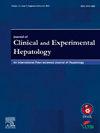Cardiac Evaluation in Liver Transplant Candidates
IF 3.2
Q2 GASTROENTEROLOGY & HEPATOLOGY
Journal of Clinical and Experimental Hepatology
Pub Date : 2025-03-27
DOI:10.1016/j.jceh.2025.102554
引用次数: 0
Abstract
Liver transplantation (LT) is the only cure for patients with end-stage liver disease. With an increase in the prevalence of obesity and associated metabolic risk factors cardiovascular disease, in particular coronary artery disease is increasingly recognised in patients with liver cirrhosis. Identification and management of these cardiovascular risk factors may influence post-transplant clinical outcomes. A detailed assessment of patients’ cardiovascular status is therefore crucial in the decision-making of patients for LT. Identification of patients with CAD requires risk stratification around perioperative and long term post-operative period. Advanced age, male sex, smoking diabetes mellitus, hypertension, obesity and metabolic-associated steatohepatitis (MASH) cirrhosis significantly increase the risk of coronary artery disease (CAD).
Patients with these high-risk factors should undergo cardiac investigations with higher sensitivity to identify CAD. Patients with low-risk factors for CAD may undergo cardiac investigations with high specificity. Patients with cirrhosis may also suffer from conditions directly related to liver disease such as cirrhotic cardiomyopathy and porto-pulmonary hypertension, and conditions unrelated to liver disease such as arrhythmias. Rarely, valvular heart disease may be identified during transplant evaluation. Clinicians managing patients for liver transplantation should carefully evaluate cardiovascular risk and treat it appropriately prior to the surgery, to minimise post-transplant complication. A multidisciplinary approach involving transplant physicians, anaesthetists, cardiologists and transplant surgeons is strongly recommended.

肝移植候选人的心脏评估
肝移植是治疗终末期肝病的唯一方法。随着肥胖和相关代谢危险因素心血管疾病,特别是冠状动脉疾病的患病率的增加,肝硬化患者越来越多地认识到。这些心血管危险因素的识别和管理可能会影响移植后的临床结果。因此,对患者心血管状况的详细评估对于患者是否接受lt至关重要。识别CAD患者需要围绕围手术期和术后长期进行风险分层。高龄、男性、吸烟、糖尿病、高血压、肥胖和代谢相关脂肪性肝炎(MASH)肝硬化显著增加冠状动脉疾病(CAD)的风险。有这些高危因素的患者应接受更敏感的心脏检查以识别CAD。低危险因素的冠心病患者可以接受高特异性的心脏检查。肝硬化患者还可能患有与肝脏疾病直接相关的疾病,如肝硬化心肌病和门肺动脉高压,以及与肝脏疾病无关的疾病,如心律失常。在移植评估过程中很少发现瓣膜性心脏病。处理肝移植患者的临床医生应在手术前仔细评估心血管风险并适当治疗,以尽量减少移植后并发症。强烈建议采用多学科方法,包括移植医师、麻醉师、心脏科医生和移植外科医生。
本文章由计算机程序翻译,如有差异,请以英文原文为准。
求助全文
约1分钟内获得全文
求助全文
来源期刊

Journal of Clinical and Experimental Hepatology
GASTROENTEROLOGY & HEPATOLOGY-
CiteScore
4.90
自引率
16.70%
发文量
537
审稿时长
64 days
 求助内容:
求助内容: 应助结果提醒方式:
应助结果提醒方式:


